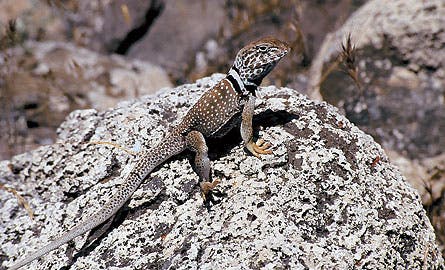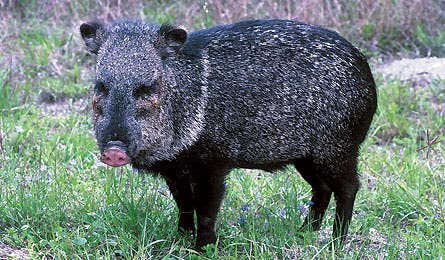Where to See More Desert Wildlife

'Mojave Black-Collared Lizard, Gary Nafis'

Mojave Black-Collared Lizard, Gary Nafis

Javelina, Don Geyer
Far from barren, the sunburnt Southwest teems with life. But because so many desert animals are nocturnal, cautious, and better camouflaged than a Green Beret, observing them is a challenge. Luckily, these species stand out, thanks to their bright colors, pungent odors, and melodic songs.
Mojave black-collared lizard
A large-headed, plump, 13-inch reptile with smooth tan and black scales.
[Display] The males’ vivid markings–dual black neck rings, orange stripes–stand out from the landscape, and help attract females.
[Habitat] Found in washes from Arizona’s Sonoran Desert to the cooler, more northern Great Basin Desert.
[Survival] Cold-blooded, it sunbathes on rocks until it’s warm enough to hunt. Can detach tail if caught.
[Signs] Perches on small rocks, or near holes for a fast retreat.
Javelina
Hoofed mammal resembling a pig. Stands knee-high with a faint white collar and dark gray coat.
[Display] Emits a skunk-like odor from rump glands to mark territories and distinguish herds.
[Habitat] Forages during daylight in dry Chihuahuan and Sonoran Desert washes.
[Survival] Unable to pant or sweat, they escape heat under overhangs or heavy brush.
[Signs] Drops piles of disc-like scat to mark territory. If alarmed, they let out a grunting cough. Often forage in groups of 5 to 15 in areas with prickly pear cacti.
Canyon wren
A palm-sized, rust-colored bird with a gray head, white throat, and long, curved bill.
[Display] Listen for the male’s cascade of whistles–which reverberate off rocky walls.
[Habitat] Seeks protection and shade inside canyons ranging from Mexico to southern British Columbia.
[Survival] Doesn’t drink water, but ingests moisture from the bodies of insects and spiders it plucks from cliff crevices.
[Signs] Mating pairs forage together, sing spontaneously in winter, and build cup-shaped nests on cliff ledges.